As the semester is winding to a close, #loweclass #digital is gearing up for its final class project. Students get the privilege of working with Milwaukee Journal-Sentinel reporter Meg Kissinger and report on the issue of mental health care in Milwaukee. Kissinger is already an established reporter in the field, and she will be helping students along with way of this project. For the final project, students were able to choose from varying occupations and roles related to mental health, from case workers to patients to the nurses who care for them. My group chose nurses, and I was pleased with the choice because they are the ones who know the patient just as well if not even more than the patient's family members. Even though I was excited about the project, I originally had no idea where to start researching for the project. I worked with autistic children over the past two summers, but learning disabilities are fairly different from mental illnesses. On their website, Milwaukee country has two different programs that will allow for nurses to take care of patients in their own homes. One program is for patients with serious and persistent mental illness, while the other is for those with developmental problems. Nurses, despite being the ones who care for the patients admitted to hospitals, also may be one of the most underrated positions within the health care field. Abele's health care plan would deny benefits to nurses who do not work 30 hours a week, which in turn could cause many nurses to leave the position and find work elsewhere. And in the death of Brandon Johnson, his family is blaming the care of the nurses. Coming into the project, I had very little knowledge of what nurses do within mental health care, and even now, my understanding is still minimal. However, this project will allow me to understand what nurses have to go through on a daily basis, and what they would change about the mental health care system. This project will be interesting.
Meg Kissinger came into #loweclass #digital last Wednesday to not only sit in on our class and learn what we are doing for Milwaukee Neighborhood News Service, but also about our project that we will be doing for the Milwaukee Journal Sentinel later in the year. Kissinger not only discussed her mental health care beat and how she got there, but also gave positive feedback for the MNNS stories.
Kissinger started out being a journalist student at Depaw University, where she worked on the student newspaper for four years. Following college, Kissinger spent a brief amount of time working in upstate New York before relocating to the Milwaukee area, where she now works for the Journal Sentinel. Covering many beats, Kissinger slowly made her way into mental heath care beat, doing various stories for the beat until she was permanently covered it.
What makes Kissinger great at her beat is that she has personal experiences with those with mental illnesses, and has a vested interest to change what's going on in mental health care. Kissinger is a part of a large family, being one of eight. However, she has also seen the horrors of mental illness, as two of her brothers and sisters have committed suicide, while another suffers from schizophrenia.
In her stories, Kissinger uses real experiences from her life and from others. Two of her stories were personal accounts of how her family coped with the deaths of her family members, which received warm responses from the public. Kissinger said in class that through her beat, if she was able to make one person's life better through her stories and through her actions on the beat.
Kissinger is a very congenial person who has a real passion not only for mental health care but for journalism in general. I'm very excited to see
The Los Angeles Times is one of the most well-known news publications in the United States. Being located in the second largest city in the country, the Times is a premium source for news. Which is why the idea of a "In Case You Missed It" section of the news site is something that I think is valuable to its readers.
Especially in the time of print journalism, if you missed a story on any given day, you never got to see it again. It was what made daily newspapers essential for journalists. But with the dawn of the internet, everything is archived and easily accessed. But you have to know the subject of the article you missed. So why not devote an entire section of the news site to giving readers the ability to search for stories that they never even heard of or couldn't know the subject of? That is the beauty of the section.
Some people have had the same idea as the Times. For instance, St. Louis's KPNT radio station does the " Discount News" on their morning show. This is the same section, where they take news that happened a few days earlier and tell their listeners the stories. They're tagline is that "if you are hearing it for the first time, well then, it's news to you."
Another section of the Times that I found interesting was the "Animals" section. The internet is a direct cause of this. If one were to go to a website such as Reddit or Imgur, they would quickly realize those who roam the internet love their animals. It provides entertainment to those who value their pets lives just as much as any other member of their family.
While these sections might not exactly be "hard news", it gives the readers of the Times a different venue from the normal news site. "In Case You Missed It" gives the readers a chance to go back the past few days and figure out what they missed in the news. And "Animals" appeals to nearly every type of person to stumble upon their site. Overall, I like these two sections, and their placement in the middle of th the page is just right.
Last week, Milwaukee Neighborhood News Service editor Sharon McGowan visited the #loweclass #digital classroom to introduce us students to the website. The website originally covered three Milwaukee city neighborhoods, covering more than just the crime that seemed to find its way into the major news outlets. Now, the news service covers fifteen neighborhoods. McGowan came into the class because we will be doing a story through the Milwaukee NNS. Milwaukee NNS has been working with Marquette, as the website is run out of Johnston Hall. McGowan told our class that while companies are sources for news service, they are not partners. They are not their personal PR service, but rather report on solutions that these companies come up with.
Because of their work so far, the Milwaukee NNS has won the regional Edward R. Murrow Award for 2012. This award is awarded for excellence in electronic journalism. To Milwaukeee NNS's credit, the majority of the writers for the service are professional writers who have come out of journalism schools in the Milwaukee area.
"No matter what field you enter, you need to know how to write," McGowan said.
Milwaukee NNS uses a variety of writing and multi-media. In class, McGowan showed a video about two Milwaukee women who were creating concerts to raise money for the community. Stories of improving the community, rather than the negative stories the larger media covers, is the goal of Milwaukee NNS.
Milwaukee NNS is a news service that uses a variety of professional and undergraduate students to write stories that include print, by-lines, and multimedia. Stories can range from the crime that the big news sources covers, to what people in the community are doing to correct these problems. I am looking forward to what story I will cover, and how the final product will look.
Over the weekend, the biggest event to hit television was the Emmy Awards. The Emmy's, which are awards for the best television, was seen by 13.2 million people, according to Press-Telegram of Long Beach, Calif. Being in Los Angeles, the Emmy's were the top trending topic on the Times website.
The Times's main headlining article had a video accompanying the article, and like we have been taught in class, the video compliments the story while not repeating the story. I clicked on the video first, and the video did an recap of the major awards, while also providing some analysis of the pick. The video also had winners' reactions and small interviews after the show. At the end of the video, the anchor breaks down some of the info that was not expressed in the live footage of the event.
I thought the video was very well done. It gave me the information that I needed to know, and probably covered the information better than the story would have. After watching the video, I scrolled down to the article. it was a sizable article, and had I not been reading the story for this blog post, I would not have read it. But, the article moved quickly as analyzed the entire show, and rarely went into who won what. The article graded sketches and acceptance speeches, and the overall idea of repeat winners.
However, outside of this article, there isn't much multimedia being used by the Times. There is a small video section on the home page, but of articles that are "human interests" stories. It seems that the Times likes to use multimedia for entertainment stories, and rely on traditional story writing for the more important stories.
I personally like what the Times is doing. I think that having the human interests stories house the video is a smart call because a video can tell the story better than a written story can. Being able to watch scenes unfold is much more appealing than reading them. But with important series, a video would distract the viewer from the more important issues, something that can be conveyed better in written stories. I would like more audio, but video is a much better su
Highlights- Garces started driving LIMOs last semester.
- He works, on average, 25 hours a week.
- Being a LIMO driver has not affected his studies.
| Vic Garces may just seem like a normal student to anyone who passes by him. The sophomore in the College of Health Sciences is not what he appears to be. While he is not Batman or Superman, he is still a part of the Student Safety program here at Marquette, specifically driving LIMOs around campus. “I don’t know why, I just love driving,” Garces said. My freshman year, I went from driving almost every day in the summer, and I got here, and I wasn’t able to bring my car. So I needed to find something that just involved driving.” Garces found the perfect job, as he works four shifts a week, two of them on weekdays and two on the weekends. Before he could even be a LIMO driver, Garces went through 25 hours of training. On total, an average week consists of 25 hours working for Student Safety. “I’ve always been a morning person,” Garces said. “I get up early in the morning and study. So I’m not really even spending that much time at night studying.” Being a LIMO driver goes against the normal college culture, as Garces, depending on his schedule, works on weekend nights instead of going out. But Garces says those nights are actually the best nights. “Weekends get hectic,” Garces said. “I love the weekends. (One weekend) I was driving the LIMO express, and 13 or 14 people got in my van. All of them were inebriated. ‘ Call Me Maybe’ came on, and they were jamming to that together. It was a hilarious moment.” However, even while jamming out with intoxicated, and hopefully of age, college students, Garces still says there are aspects of the job that he does not like. “I feel bad when people have to wait, but there’s really nothing we can do,” Garces said. “We’re doing the best we can, we’re operating at full speed every time, but if you have to pick someone up door to door, it takes a lot of time.” |
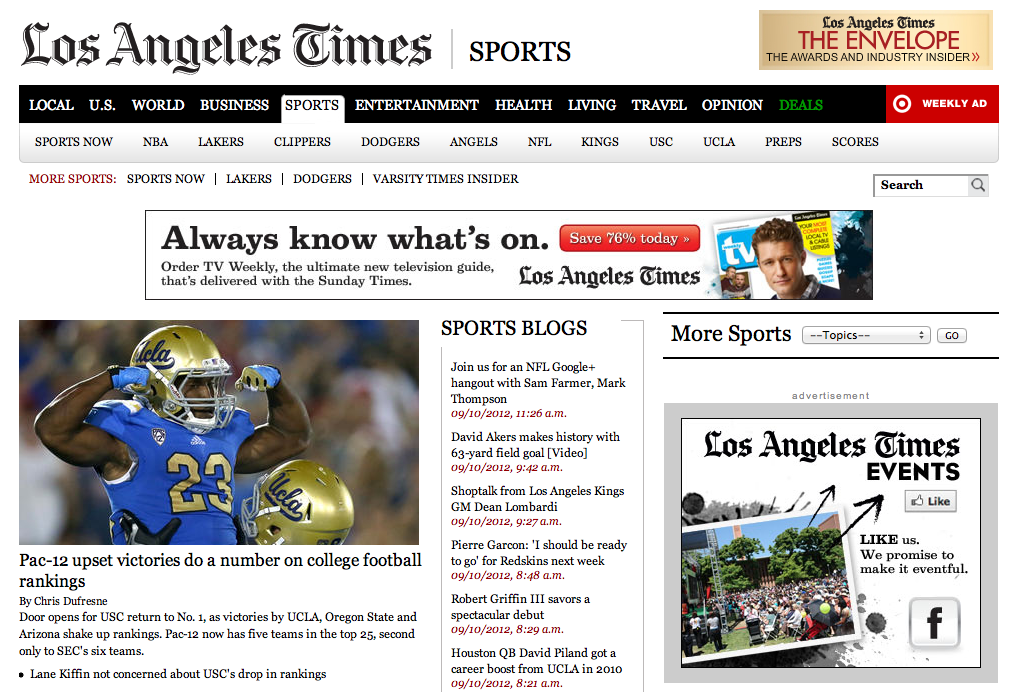 Pac-12 college football, rather than NFL football, graces the sports homepage of the Los Angeles Times for the weekend review. The Los Angeles Times has an interesting situation when it comes to weekend football. Los Angeles has two major colleges in the area, University of Southern California, and University of California-Los Angeles. USC is ranked no. 2 in the AP Poll, and no. 3 in the USA Today (coaches') poll. However, the Los Angeles area has no local team, but there are three major teams in the Southern California area (San Diego Chargers, San Francisco 49ers, and Oakland Raiders). The Times stayed with the local aspect of the paper, and predominantly featured college football over the NFL. The Times focused on college football in the weekend wrap-up. The main headline was Pac-12 teams playing spoiler to Top 25 teams. Unranked Oregon State played no. 13 Wisconsin at Reser Stadium, and held the Wisconsin offense to just seven points. The Beavers led 3-0 at the half, and scored a touchdown in the 3rd before holding off the Badgers to win 10-7. UCLA hosted Nebraska, and went blow for blow against the Huskers until a touchdown and safety in the 4th quarter sealed the win for the Bruins. Oklahoma State went into Arizona Stadium to face the Arizona Wildcats. The Wildcats took the lead in the second half, and never looked back, defeating the Fiesta Bowl champions 59-38. College football and the Pac-12 upsets was the main story for the sports section, but NFL football did find its way onto the newspaper's website. On the Times homepage, there was a video link for Times' writers discussing Week 1 of the NFL season. On the NFL homepage, Robert Griffin III and his upset over the New Orleans Saints was the lead story. But there was no mention of the San Francisco 49ers defeating the Green Bay Packers at Lambeau Field. The only preview for the Monday night showdown between the Oakland Raiders and San Diego Raiders, is a surface level look at the team's major performers and the head coaches. The Times may not have a football team, but are still a prominent name in the journalism world. It focuses on local issues first, and then expands to the country's issues, and it seems that the same can be said for sports. However, being a prominent name, I would have expected more coverage of the nation's favorite sport, regardless if there is an actual "home team" to cover. But, I guess USC and their title hopes are more important than another city's professional team.
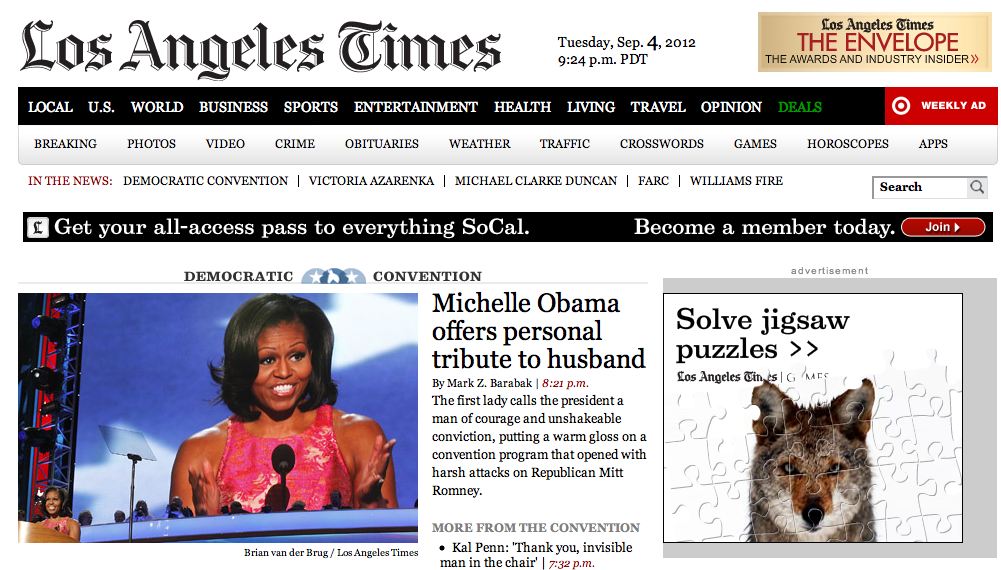 A screenshot of the Los Angeles Times' homepage, where first lady Michelle Obama dominates the main headline. For those who have not read my blog post in JOUR 4932, each student in #loweclass was assigned a beat area, and my beat for #digital is the Los Angeles Times, and for #sports, I am covering the sports section of the Times. I was not extremely familiar with the Times before being assigned this beat. I have family out in Orange Country, Calif., which is fairly close to Los Angeles, and gives me a reason to see how the news of this region affects the people living there. But other than having family, I have no connection to Los Angeles, which is also what makes covering this beat area interesting. The first thing that caught my eye was how the section bar was laid out. I really liked how it went from local, to U.S., to world. What was most important to the readers was the first thing that they read, and it then expanded to the next most important, the U.S., and then to world, which was the least important of the hard news. It shows understanding by the web developers and the newspaper company itself to recognize what is important to its readers. The next impressive thing about the Times was its world section. The most important headlines are on the left hand side, some with photos and some without. To the right of the headlines are ads and links for multimedia stories. But the feature I like the most is the layout of the stories that are towards the bottom of the page. If a reader were to scroll down, they would find headlines from all regions of the world, and they are grouped together by region. There are headline stories from Afghanistan and Pakistan, Africa, Europe, and Latin America, just to name a few of the regions covered. And if you click on the section's heading, it will link you to a page specifically devoted to stories of that region, just as if someone were looking for the sports section or entertainment. My initial thoughts on the Times is that it was a major market newspaper that caters to the people that live in that specific region before branching out to those in the U.S. and in the world. But, the newspaper have a complete understanding of what their readers want to hear, and the layout of the site reflects it. In addition, they also make it very easy to find specific stories about specific topics. Overall, I believe that covering the Times will be a very interesting assignment to continue throughout the year.
|
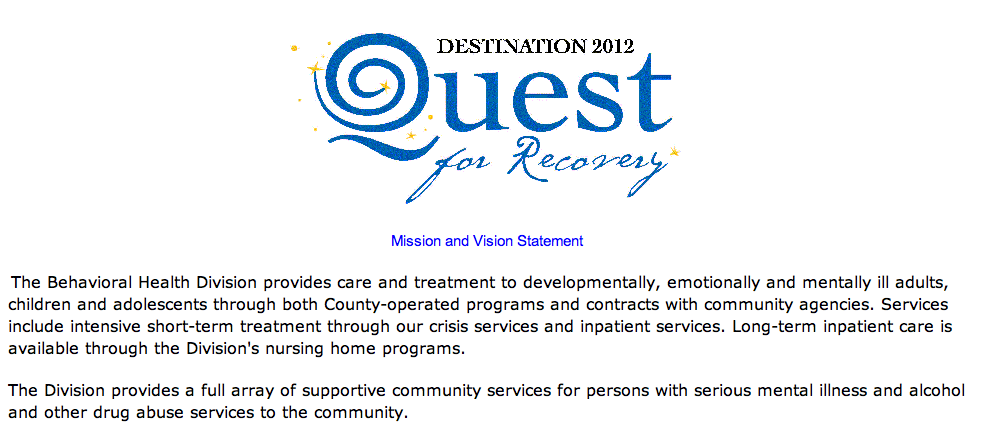
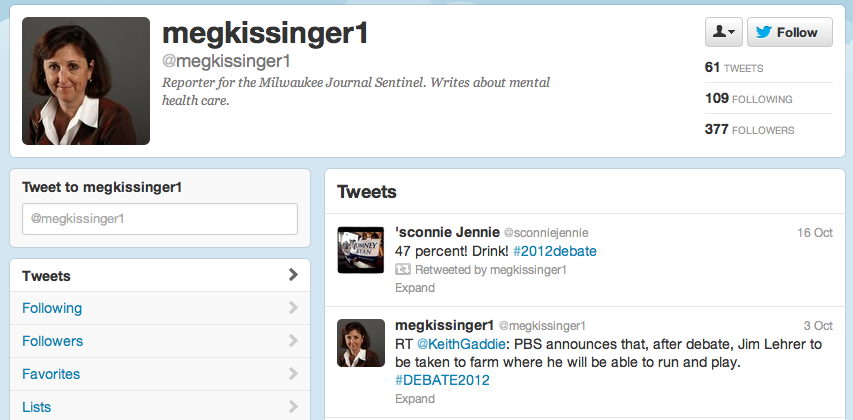
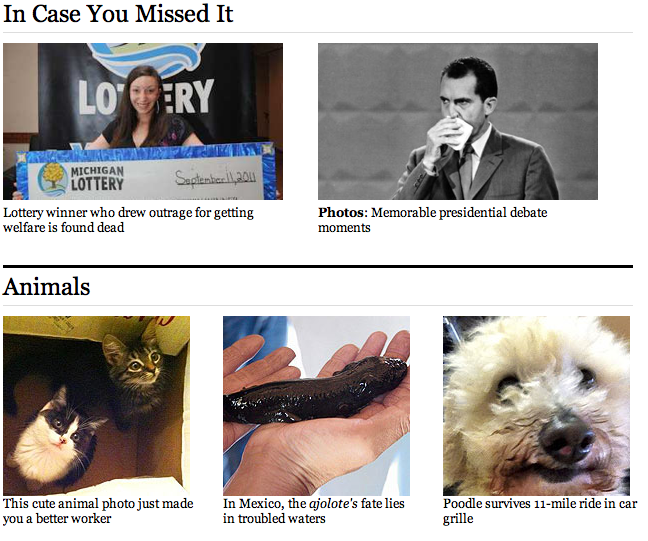
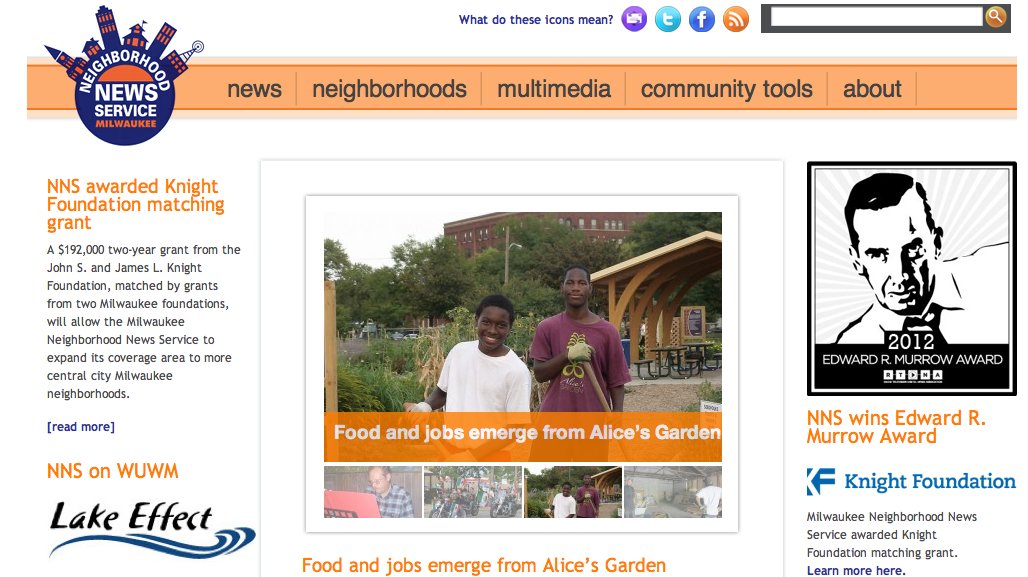



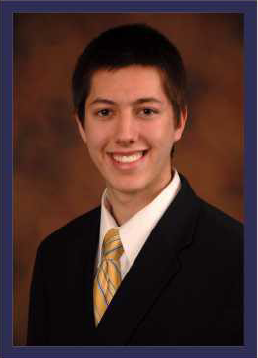
 RSS Feed
RSS Feed